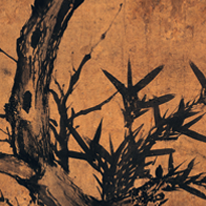Past Exhibitions
- Song and Yuan Paintings in Kyoto
- September 13, 2014 - October 13, 2014
Paintings from China's Song (960-1279) and Yuan (1271-1368) dynasties, with their unwaveringly meticulous brushwork and profound spirituality, served as models for Japanese painters, especially in the Heian (794-1185), Kamakura (1185-1333), and Muromachi (1392-1573) periods. Many Chinese paintings that were brought into Japan--including landscapes and bird-and-flower paintings from China's Imperial Painting Bureau--found their ways into the collections of the shogunate government and temples. In Kyoto, the Ashikaga shoguns assembled a collection known as the Higashiyama Gomotsu, whose Chinese artworks (karamono) were used chanoyu, the Way of Tea. Some of the most prized among these treasures were paintings by Muqi Fachang (1210?-1269?), a Southern Song priest-painter whose pale ink brushwork greatly influenced the development in Japan of a distinctive, refined aesthetic that differed from the tastes of Continental Chinese.












